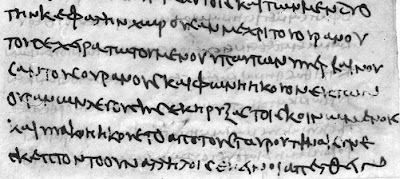 |
| Typical earlier Greek Papyrus: Click to Enlarge |
 |
| paint-brush versus quill - Click to Enlarge |
This softer paint-like writing was practically necessary, because of the relative roughness and fragility of papyrus, which was a primitive paper-like material, as opposed to later parchment and vellum (animal skins).
It is true that sometimes the early Egyptian scribe using papyrus would give a slight to moderate tilt or angle to the letters, but this varies from scribe to scribe, and can hardly be defined even as a conscious choice. The tilt is probably based on practical factors like right- or left-handedness, and not issues of style at all. The early slight to moderate tilt may be quite noticeable in more extreme cases, but does not seem to be a choice based on anything but writing convenience and speed. There is no dispute however, that slanted writing was popular quite early, as a few samples of P45 can illustrate:
 |
| P45 - Click to Enlarge |
P45 wasn't available to Sanders (P45 was discovered in 1930), but probably would have been preferred by him as an example of early slanted writing over the Greek Enoch fragments from P. Cair. 10759 below:
Papyrus Cairo 10759
 |
| Gospel of Peter (Click to Enlarge) |
 | |
| Enoch (Click to Enlarge) |
We have already referred to Schmid's excellent and thorough article in The Freer Biblical Manuscripts (2006), Ed. Larry W. Hurtado, and we will quote his passage of Sanders here:
"Hand 'c' [of Enoch] bears a much closer resemblance to the hands of W...The ease, grace, and slope of the hand remind one strongly of the first hand of W, but the shapes of many of the letters, notably γ ε κ μ σ ω are far closer to [the 1st quire of John in W]. I see no reason for not considering the two hands of the Enoch fragment contemporary. It [Enoch] has been dated to the 6th century, but though both hands are somewhat more developed types than the hands of W, I should not place the date later than the end of the 5th [century]." (Sanders, 137-8, in Schmid, p. 239)
And if so, trying to make Codex W the archetype of other 5th/6th century witnesses is a naive and flimsy proposal. But why does it matter? Because Codex W is now no longer an early "4th or 5th century" witness to other palaeographic features, such as outdented and enlarged letters, slanted varying-width styles, etc. - But rather, a very late witness.
mr.scrivener


if you don't mind me asking, where did you find the images of P45?
ReplyDelete